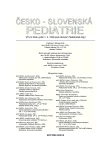Acute Pyelonephritis – A Questionnaire Study of Diagnostics and Treatment in the Czech Republic
Authors:
M. Procházka; F. Votava
Authors‘ workplace:
Klinika dětí a dorostu, UK 3. LF a FN Královské Vinohrady, Praha
přednosta doc. MUDr. F. Votava, PhD.
Published in:
Čes-slov Pediat 2010; 65 (2): 62-71.
Category:
Original Papers
Overview
The aim of this paper is to analyse results of a questionnaire study on the diagnosis and therapy of acute pyelonephritis in children.
Results:
Among the diagnostic criterions of principle importance there are positive bacteriuria, CRP elevation, fever and abnormal finding on the static renal scintigraphy performed during the acute phase of infection. Collection of the middle-stream urine specimen into a sterile test-tube is the most common approach. Biochemical testing together with culture and sensitivity are preferred to dipstick methods. The duration of the antibiotic treatment depends on the age of the child – usual course varies from 10 to 14 days with usual 3 to 5 days of the initial parenteral treatment. There is a considerably large group of patients treated only with orally administered antibiotics. Cephalosporins of the 2nd generation are the commonly used antibiotics . Routine antibiotic prophylaxis after the first infection of acute pyelonephritis is recommended by 42 %, in case of recurrent infection by 48 % of the addressed pediatricians. The common duration the prophylactic administration of antibiotics is 6 weeks. Indication of micturition cystourethrography in patients with primary infection as well as with recurrent infection is influenced by the age of the patient (age limit 5 years for routine performance in both sexes). Another powerful factor influencing its indication is the presence of further risk factors. About a half of pediatricians routinely indicate static renal scintigraphy outside the acute infection phase in the pre-school children group. The rest indicate this examination only in the specific group of children that have a higher risk of infection. Generally, it is believed that acute pyelonephritis is not diagnosed more often than is its real occurrence.
Conclusion:
This work shows big variability of current medical approaches and supports the view that clear and widely accepted guidelines are currently absent in the Czech Republic. There is an evident aim to apply the least harmful medical approaches especially in case of the first uncomplicated infection and among older children.
Key words:
acute pyelonephritis, urinary tract infection, diagnosis, treatment
Sources
1. Downs SM. Technical report: urinary tract infection in febrile infants and young children. The Urinary Tract Subcommittee of the American Academy of Pediatrics Committee on Quality Improvement. Pediatrics 1999; 103: 54.
2. Westwood ME, Whiting P, Cooper J, Watt IS, Kleijnen J. Further investigation of comfirmed urinary tract infection (UTI) in children under five years: a systemic review. BMC Pediatrics 2005; 5: 2.
3. Marks SD, Gordon I, Tullus K. Imaging in childhood urinary tract infections: time to reduce investigations. Pediatr. Nephrol. 2008; 23: 9–17.
4. Bláhová K, Janda J. Diagnostika a léčba akutní pyelonefritidy. In: Lebl J, Janda J, Pohunek P. Praktická pediatrie. Praha: Galén, 2008: 61–70.
5. Jodal U, Hansson S. Guidelines for Diagnosis and Managment of Urinary Tract Infection: 36th Annual Meeting European Society of Pediatric Nephrology, Practical Nephrology and Clinical Conferences Handbook, September 20–13, 2002. Bilbao, Spain.
6. Hodson EM, Willis NS, Craig JC. Antibiotics for acute pyelonephritis in children. Cochrane Database Syst Rev. Cochrane Database Syst Rev. 2005;(1):CD003772.
7. Pohl A. Modes of administration of antibiotics for symptomatic severe urinary tract infections. Cochrane Database Syst Rev. 2007 Oct 17;(4):CD003237.
8. Kolský A, Kolská M, Bébrová E, Jiroušová K, Urbášková P. Terapie infekcí močových cest u dětí. Urologie pro praxi 2008; 9(4): 171–176.
9. Conway PH, Cnaan A, Zaoutis T, Conway PH, Cnaan A, Zaoutis T. Recurrent urinary tract infections in children: Risk factors and association with prophylactic antimicrobials. Pediatr. Urology 2007; 298: 179–186.
10. NICE Guidelines – Urinary tract infection in children diagnosis, treatment and long-term management. August 2007, http://www.nice.org. uk/nicemedia/pdf/CG54fullguideline.pdf.
11. Montini G, Rigon L, Zucchetta P, et al. Prophylaxis after first febrile urinary tract infection in children? A multicenter, randomized, controlled, noninferiority trial. Pediatrics 2008; 122(5): 1064–1071.
12. Bláhová K, Gut J. Mikční cystouretrografie a urodynamické vyšetření u dětí. In: Lebl J, Janda J, Pohunek P. Praktická pediatrie. Praha: Galén, 2008: 71–76.
13. Montini G, Rigon L, Zucchetta P, et al. Value of imaging studies after a first febrile urinary tract infection in young children: Data from Italian Renal Infection Study 1. Pediatrics 2009 Feb; 123(2): e239–e246.
14. American Academy of Pediatrics. Committee on Quality Imporvent, Subcomittee on Urinary Tract Infection, Practica Parameter. Diagnosis, Treatment, and Evaluation of the Initial Urinary Tract Infection in Febrile Infats and Young Children. Pediatrics 1999 Apr; 103(4), http:// pediatrics.aappublications.org/cgi/content/full/103/4/e54.
Labels
Neonatology Paediatrics General practitioner for children and adolescentsArticle was published in
Czech-Slovak Pediatrics

2010 Issue 2
- What Effect Can Be Expected from Limosilactobacillus reuteri in Mucositis and Peri-Implantitis?
- The Importance of Limosilactobacillus reuteri in Administration to Diabetics with Gingivitis
Most read in this issue
- Acute Kidney Injury – Classification, Etiology, Diagnosis
- Disorders of Sex Development: Currently Recommended Classification and New Knowledge of Gonadal Maldevelopment
- Acute Pyelonephritis – A Questionnaire Study of Diagnostics and Treatment in the Czech Republic
- Occurrence of Metabolic Syndrome and Its Components in Obese Children
